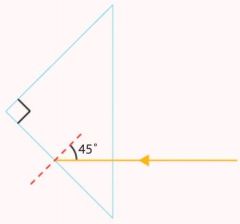![]()
![]()
![]()
Use LEFT and RIGHT arrow keys to navigate between flashcards;
Use UP and DOWN arrow keys to flip the card;
H to show hint;
A reads text to speech;
16 Cards in this Set
- Front
- Back
|
What is the critical angle? |
Waves going from a dense medium to a less dense medium speed up at the boundary. This causes light rays to bend when they pass from glass to air at an angle other than 90º. This is refraction.
Beyond a certain angle, called the critical angle, c, all the waves reflect back into the glass. The critical angle for most glass is about 42 °. |
|
|
What is total internal reflection? |
Beyond a certain angle, called the critical angle, c, all the waves reflect back into the glass. We say that they are totally internally reflected. |
|
|
Which equation can be used to calculate the critical angle? |
sin c = 1 ÷ refactive index where c is the critical angle |
|
|
What is an optical fibre? |
An optical fibre is a thin rod of high-quality glass, high refractive index in the centre surrounded by glass with a lower refractive index. Very little light is absorbed by the glass. Light getting in at one end undergoes repeated total internal reflection, even when the fibre is bent, and emerges at the other end. |
|
|
Name two uses of optical fibres. |
Optical fibres are used in endoscopes that allow surgeons to see inside their patients. Optical fibres can also carry enormous amounts of information as pulses of light. |
|
|
How does an endoscope work? |
Endoscopes use optical fibres. A doctor can insert a bundle of optical fibres into the body. Some carry light into the body, and some carry light reflected off internal body surfaces back out. This allows the doctor to see the inside of the body clearly – and help them diagnose diseases like cancer, or see what they are doing during keyhole surgery. |
|
|
How is information carried over optical cables? |
Information such as computer data and telephone calls can be converted into electrical signals. These are converted into either visible light signals or infrared signals, and transmitted by optical fibres. Optical fibres can carry more information than an ordinary cable of the same thickness. The signals in optical fibres do not weaken as much over long distances as the signals in ordinary cables. |
|
|
What is a laser? |
A laser - 'Light Amplification by Stimulated Emission of Radiation' - produces an intense narrow beam of light. The light from a laser is monochromatic (a single colour). Some lasers are capable of heating materials. This makes them useful in surgery and for cutting metals and other industrial materials. |
|
|
Describe two uses for lasers.
|
Any two from: eye surgery, cauterising wounds/blood vessels, writing CDs/DVDs. |
|
|
Lasers are used to scan bar codes in shops. How would you expect a surgeon’s laser to be different from the laser in a supermarket scanner? |
The surgeon’s laser would be more powerful. The lasers in supermarkets must be safe in case a hand gets in the way or if someone looks into the laser. |
|
|
The refractive index for water is 1.33. What is the critical angle for water? |
sin c = 1 ÷ 1.33 = 0.752 c = 48.75° |
|

The figure shows light entering a glass prism. Copy the diagram and draw the path the light will take. Explain your answer. |
The light is reflected back to where it came from (the prism acts like a mirror). |
|
|
If you are swimming underwater, the surface of the water often looks shiny. Why do you think this is? Draw a diagram to help you to explain. |
Some light from the water is totally internally reflected from the surface of the water. Diagram to show this. |
|
|
Suggest why it might be more difficult to repair a telecommunications cable that uses optical fibres than one using electrical conductors. |
An electrical connection can be made just by connecting wires together. For optical fibres, the two fibres would have to be joined at the correct angle so light could go from one to the other. |
|
|
Explain what total internal reflection is and why it does not happen when light passes from air into glass. |
Total internal reflection occurs when light reaches a boundary. If the angle of incidence is greater than the critical angle as light passes from a material such as glass or water and into a material where it travels faster, such as air, the light will be reflected at the boundary and none will be refracted/pass out of the material. |
|
|
What are the key points to remember? |
Light can be reflected as it leaves a medium such as glass. If the angle of incidence at the glass to air interface is bigger than the critical angle, total internal reflection will occur. refractive index = 1 ÷ sin c Optical fibres are made of two layers of glass, with the outer layer having a lower refractive index. Light is totally internally reflected inside optical fibres. Uses of optical fibres include endoscopes, which can be used by doctors to look inside patients. Lasers are narrow beams of light that can be used in CD and DVD players, for eye surgery, and for cutting, burning and cauterising. |

